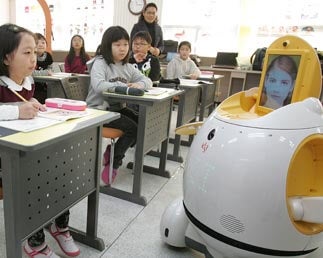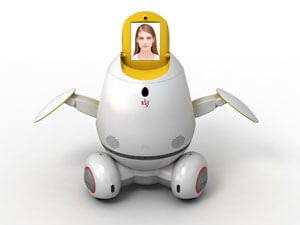
South Korea is testing robots that could help foreigners to reach out and teach someone. 29 robots were recently deployed in 21 schools in the city of Daegu to help human children learn English. The bots, named EngKey, can be used as telepresence platforms to bring experienced educators from the Phillipines into the classroom via a small screen at the head of the robot. The Filipino teachers communicate using embedded microphones and speakers. These bots were developed by the Korean Institute of Science and Technology (KIST) and are part of a larger scale automation of English education. South Korea is hoping to have a robot in every kindergarten classroom by 2013. Around 150 government officials were on hand at Hakjung Elementary School for the start of EngKey’s telepresence trials, which are estimated to cost 1.6 billion won (~$1.39 million USD). While this is only a small step towards Korea’s grandiose goals of robotic education, it’s a good sign that the nation is serious about automation in schools. Give it time and robots could become as common in Korean classrooms as chalkboards.
As we discussed in previous coverage of the robot teacher phenomenon, South Korea employs a vast number of English teachers, many of whom (30,000+) are imported from countries like Canada, the US, and South Africa. The costs of these teachers, which can include compensation for their initial travel costs, housing, and some living expenses, is significant. By augmenting their English studies programs with robots South Korea is not only reducing expenses, but also pushing their students into a closer understanding and familiarity with advanced technology. Save money and prepare your kids for the 21st century – it’s a program with definite appeal for the nation.

EngKey is one of several robots that will help form the first wave of mechanical maestros. They cost around 10 million won (~$8700) but officials are hoping to cut that price, perhaps by as much as one half. Current models of EngKey are about one meter tall and have a distinctly egg-shaped body with short arms. The look of the robot is meant to inspire kids to trust and enjoy its presence, helping children who are normally too shy around adults to open up and interact more in class. EngKey recently completed a fourteen week trial in which it was used by children of various ages in the Korean cities of Daegu and Masan. That study, however, focused on the robot as a purely automated device. It helped students with pronunciation and communication skills using pre-written (and rigidly followed) scripts.
The newest trial is at once both more flexible and less robotic. While EngKey’s small screen can display a cartoonish face, for the recent telepresence trials the robot puts on the appearance of a realistic human avatar. (I’m going to avoid a big discussion about race and cultural assumptions and just say that the choice to have the avatar always appear as Caucasian is ‘interesting’). When controllers in the Phillipines, all experienced English educators, change their facial expressions the movements are detected by a camera and the avatar mimics them. Children see the avatar react in a human way. As such, the Korean students can receive higher quality and more subtle instruction than the EngKey can provide on its own. At the same time, they are still interacting with an advanced technological device.
Current trials will have students practicing English with the Filipino teachers via telepresence three times per week and practicing pronunciation and conversation with the automated EngKey programs twice a week. Most of the fully automated scripts seem to be designed to work with a single student, while the telepresence applications allow the Filipino instructors to interact with groups of children. According to the JoongAng Daily, the upper limit for these tele-robotic sessions is about eight students. It’s unclear if that is a restriction due to the technology (because of range of vision, or sensitivity of microphones) or reasonable expectations about the discipline of kids.
New trials with the EngKey robot are a great example of the powerful influence that robots can have in the classroom. These devices are more than just interactive programs in physical bodies, they are portals to the outside world and ambassadors of advanced technology. As Korea continues to step up its program to automate classrooms (and they are scheduled to spend 50 billion won, ~$44 million, by 2013) we’re likely to see more applications that take advantage of EngKey’s diverse capabilities. In the past I’ve viewed telepresence functions in education robotics as a bridge that will help developers cover the gap between the very limited robots of today and the better-than-human models of the far future. The Filipino education trial, however, has me thinking about the important ways that telepresence can extend beyond the boundaries of traditional classroom instruction. Government officials could tele-commute in and use the bots to get first-hand glimpses into the classrooms. Parents could watch (maybe even discipline) their kids. Specialists from all over the world could give presentations about their fields. All the while, the presence of the EngKey will be influencing the students as a clear reminder of the importance and promise of careers in science and technology.
29 robots is a relatively small trial, especially when Korea hopes to employ tens of thousands in just a few years. Each success, however, validates the plan for robots to augment education. Similar programs in Japan and around the world will do the same. The last 200 years have dramatically altered the landscape of education, from an advantageous privilege of the relative few to a dire necessity for the masses. The increasing inclusion of robotics, telepresence, and the internet, could change education even more… and in far less time.
[image credit: Gong Jeonk-sik]
[sources: imaeil (KR), JoongAng Daily]


